Our approach to colon cancer treatment
Our comprehensive colon cancer care gives you access to expert medical teams, advanced treatments and holistic support. As Texas's largest hospital-based cancer network, we offer a range of treatment options and resources to create a health plan tailored to your needs.
Today, you have more treatment options for colon cancer than ever before, and our teams continue to advance colon cancer care through innovative research and studies. Guided by our expertise, you can confidently decide the most suitable treatment for you.
Surgery for colon cancer
Surgery is one of the main treatments for colon cancer, with different possibilities based on the type and stage of your cancer. When colon cancer is found in its earliest stages, surgery is often the only treatment required. In later stages, surgery is used together with other treatments to fight colon cancer.
Surgical treatment aims to remove the primary colon cancer as well as the associated lymph nodes and affected tissue. Surgery is also used to help manage or relieve symptoms of colon cancer. Depending on how much your colon cancer has grown or spread, you may have minimally invasive surgical options or treatments to preserve your normal digestive function.
Polypectomy
Most colon cancers start as a polyp, a small, abnormal tissue growth in the colon. In the earliest stages of colon cancer—stage 0 and sometimes stage 1—you may have a polypectomy to remove a polyp that contains cancerous cells. A polypectomy can be performed during a colonoscopy procedure, where your doctor uses a scope to view the polyp and remove it.
Endoscopic mucosal resection (local excision)
Endoscopic mucosal resection removes an area of colon cancer without an abdominal incision. Like a polypectomy, this procedure is performed during a colonoscopy. Endoscopic mucosal resection is used in the early stages of colon cancer. During a local excision, your doctor removes the cancerous polyp and some healthy tissue surrounding it.
Colectomy
A colectomy removes part of the colon or the entire colon and nearby lymph nodes. It’s sometimes called colon resection surgery. Traditional open colectomy uses a single incision in the abdomen. You may also have the option of laparoscopic surgery, which uses smaller incisions, or robotic surgery.
When you have a colectomy, your care team will take steps to reconnect your digestive tract to allow you to pass stool the natural way. Usually, this can be done without an ostomy (such as a colostomy or ileostomy) by using anastomosis to connect the remaining pieces. For example, an ileocolonic anastomosis connects the end of the small intestine to the remaining part of the colon.
- Total colectomy: The term total colectomy means the entire colon is removed. This type of surgery is not as common in colon cancer treatment, but it might be recommended if polyps or cancer are found throughout the colon or if the cancer is due to a genetic familial condition.
- Partial colectomy: Often, your care team only removes part of the colon, called a segmental colectomy. In most cases, this surgery removes about 1/4 to 1/3 of the colon.
- Hemicolectomy: A hemicolectomy is a partial colectomy that removes one side of the colon. You may have a right hemicolectomy or a left hemicolectomy, depending on where the cancer is in the colon.
- Proctocolectomy: During a proctocolectomy, the colon and the rectum are surgically removed. To pass stool through the anus, your surgeon can create an ileal pouch to replace the function of the removed intestinal tract.
Radiofrequency ablation
Radiofrequency ablation is an alternative treatment for individuals who are not suitable candidates for surgery or when colon cancer has spread to the liver. It uses high-frequency radio waves via a probe to generate heat and eliminate cancer cells in the liver.
Cryosurgery
When colon cancer can’t be removed by traditional surgery or spreads to the liver, cryosurgery is another option. This procedure uses a probe and very cold temperatures to freeze cancer cells and the tissue around the cancer in the liver.
Medical treatment
In advanced stages (3 or 4) of colon cancer, a combination of medical and surgical treatments is often used. In some advanced types of colon cancer, medical treatments may be the primary source of care.
Common medical treatments include chemotherapy, radiation therapy, targeted therapies or immunotherapy. The choice and sequence of treatments depend on several factors, and if one treatment is ineffective, your care team may explore alternative medical options.
Chemotherapy
Chemotherapy uses drugs to destroy or stop cancer cells from rapidly growing or multiplying. You may receive these drugs through an IV or as a pill. Your care team may use chemotherapy after surgery depending on the final stage of the cancer, while occasionally, colon cancer needs chemotherapy before surgery.
- Adjuvant chemotherapy: Adjuvant chemotherapy is given after surgery. It targets any cancer cells that couldn’t be surgically removed and helps reduce the chance of cancer spreading or returning.
- Neoadjuvant chemotherapy: Neoadjuvant chemotherapy shrinks the size of the tumor before surgery.
Targeted drug therapy
Targeted therapies are an option for people with advanced colon cancer. These drugs often work with chemotherapy to target and destroy specific proteins or chemicals in colon cancer cells. One of the most common targeted therapies for colorectal cancer is monoclonal antibodies.
Immunotherapy therapy
Immunotherapy uses the power of your immune system to fight cancer. It is one of the most recent advances in colon cancer treatment. The Food and Drug Administration approves a type of immunotherapy called checkpoint inhibitors for advanced-stage colon cancer. This therapy works by blocking a receptor on cancer cells, allowing your immune system to recognize and attack the tumor.
Radiation therapy
Radiation therapy for colon cancer isn’t a standard colon cancer treatment. It’s more common in rectal cancer care. However, it may be used with chemotherapy, called chemoradiation, for specific cases.
If your care team recommends radiation therapy, you’ll talk about the goals of your specific treatment. Radiation therapy can reduce the size of a tumor before surgery, destroy cancer cells that remain during or after surgery or reduce symptoms of advanced-stage colon cancer.
Types of radiation
During this therapy, your care team uses high-energy beams of radioactive material to help destroy cancer cells. The two main types of radiation are external-beam radiation therapy and brachytherapy.
- External-beam radiation therapy: This therapy delivers radiation from a machine outside the body. It’s the type of radiation used most often in colon cancer treatment.
- Brachytherapy: Also known as internal radiation therapy, brachytherapy delivers radiation via a needle or catheter inside the body.
Colostomy or ileostomy
If you need surgery to remove your colon to treat colon cancer, your care team may talk with you about an ostomy procedure, such as a colostomy or ileostomy.
These procedures reconnect your intestinal tract to an opening in the abdomen called a stoma. Stomas allow stool to pass out of the body into a pouch. When the end of the small intestine is connected to the stoma, it’s called an ileostomy. When the remaining portion of the colon is connected, it’s called a colostomy.
With advances in surgery, many colon cancer surgeries use anastomosis, which reconnects the digestive tract on the inside and eliminates the need for an ostomy. Some people require a temporary colostomy or ileostomy to give their body time to heal. According to the Colorectal Cancer Alliance, less than 10% of people who undergo colon cancer surgery will have a permanent colostomy or ileostomy.
If you need a temporary or permanent colostomy or ileostomy, many of our locations provide specially trained ostomy nurses who will equip you with the knowledge to manage your stoma and pouch confidently.
Finding specialized colon cancer treatment
We offer several locations for your care, including specialized colon cancer treatment centers in North and Central Texas

Baylor Scott & White Cancer Center - Round Rock
300A University Blvd , Round Rock, TX, 78665- Monday: 8:00 am - 5:00 pm
- Tuesday: 8:00 am - 5:00 pm
- Wednesday: 8:00 am - 5:00 pm
- Thursday: 8:00 am - 5:00 pm
- Friday: 8:00 am - 5:00 pm

Baylor Scott & White Charles A. Sammons Cancer Center - Dallas
3410 Worth St , Dallas, TX, 75246
Baylor Scott & White Charles A. Sammons Cancer Center - Duncanville
310 E Hwy 67 , Duncanville, TX, 75137- Monday: 8:00 am - 5:00 pm
- Tuesday: 8:00 am - 5:00 pm
- Wednesday: 8:00 am - 5:00 pm
- Thursday: 8:00 am - 5:00 pm
- Friday: 8:00 am - 5:00 pm

Baylor Scott & White Charles A. Sammons Cancer Center - Irving
2001 N MacArthur Blvd Ste 120, Irving, TX, 75061
Baylor Scott & White Charles A. Sammons Cancer Center - Waxahachie
2380 N Interstate 35E , Waxahachie, TX, 75165- Monday: 7:30 am - 4:30 pm
- Tuesday: 7:30 am - 4:30 pm
- Wednesday: 7:30 am - 4:30 pm
- Thursday: 7:30 am - 4:30 pm
- Friday: 7:30 am - 4:30 pm
- Saturday: 7:30 am - 4:30 pm
- Sunday: 7:30 am - 4:30 pm

Baylor Scott & White Colon and Rectal - Waxahachie
2360 N Interstate 35E Ste 310, Waxahachie, TX, 75165- Monday: 8:00 am - 5:00 pm
- Tuesday: 8:00 am - 5:00 pm
- Wednesday: 8:00 am - 5:00 pm
- Thursday: 8:00 am - 5:00 pm
- Friday: 8:00 am - 5:00 pm

Baylor Scott & White Colon and Rectal Surgical Consultants of North Texas - Dallas
9101 N Central Expy Ste 300C, Dallas, TX, 75231- Monday: 8:00 am - 4:30 pm
- Tuesday: 8:00 am - 4:30 pm
- Wednesday: 8:00 am - 4:30 pm
- Thursday: 8:00 am - 4:30 pm
- Friday: 8:00 am - 4:30 pm

Baylor Scott & White Colon and Rectal Surgical Consultants of North Texas - Plano
4716 Alliance Blvd Ste 210, Plano, TX, 75093- Monday: 8:00 am - 4:30 pm
- Tuesday: 8:00 am - 4:30 pm
- Wednesday: 8:00 am - 4:30 pm
- Thursday: 8:00 am - 4:30 pm
- Friday: 8:00 am - 4:30 pm

Baylor Scott & White Colon and Rectal Surgical Consultants of North Texas at The Star
3800 Gaylord Pkwy Ste 910, Frisco, TX, 75034
Baylor Scott & White Vasicek Cancer Treatment Center - Temple
2401 S 31st St , Temple, TX, 76508- Monday: 8:00 am - 5:00 pm
- Tuesday: 8:00 am - 5:00 pm
- Wednesday: 8:00 am - 5:00 pm
- Thursday: 8:00 am - 5:00 pm
- Friday: 8:00 am - 5:00 pm

Baylor University Medical Center, part of Baylor Scott & White Health
3500 Gaston Ave , Dallas, TX, 75246
Lonestar Endoscopy Center - Flower Mound
1001 Surrey Ln , Flower Mound, TX, 75022- Monday: 5:00 am - 3:00 pm
- Tuesday: 5:00 am - 3:00 pm
- Wednesday: 5:00 am - 3:00 pm
- Thursday: 5:00 am - 3:00 pm
- Friday: 5:00 am - 3:00 pm

Lonestar Endoscopy Center - Southlake
515 S Nolen Dr , Southlake, TX, 76092- Monday: 5:00 am - 3:00 pm
- Tuesday: 5:00 am - 3:00 pm
- Wednesday: 5:00 am - 3:00 pm
- Thursday: 5:00 am - 3:00 pm
- Friday: 5:00 am - 3:00 pm

North Central Surgical Center Hospital
9301 N Central Expy Ste 100, Dallas, TX, 75231
Tuscan Surgery Center at Las Colinas
701 Tuscan Dr Ste 100, Irving, TX, 75039- Monday: 6:00 am - 5:00 pm
- Tuesday: 6:00 am - 5:00 pm
- Wednesday: 6:00 am - 5:00 pm
- Thursday: 6:00 am - 5:00 pm
- Friday: 6:00 am - 5:00 pm